Overview
Creating a new table in Power BI from existing tables offers a variety of methods, including:
- Manual entry
- DAX formulas
- Power Query transformations
Understanding these techniques is essential for enhancing data manipulation capabilities. Mastering these skills not only improves operational efficiency but also informs decision-making in the realm of business intelligence. By leveraging these methods, professionals can significantly elevate their analytical practices and drive better outcomes.
Introduction
In the realm of data analytics, Power BI emerges as a formidable tool, empowering organizations to convert raw data into actionable insights. At the core of this transformation is the creation and management of tables—essential building blocks for organizing and analyzing information.
Whether dealing with sales transactions or customer profiles, well-structured tables enable effective data visualization and informed decision-making. Yet, many users face hurdles in mastering the diverse methods of table creation, be it through manual entry, DAX formulas, or Power Query.
This article explores crucial techniques and best practices for creating and managing tables in Power BI, equipping readers with the knowledge necessary to enhance their analytical capabilities and drive operational efficiency.
Understanding the Basics of Table Creation in Power BI
In this software, grids serve as essential components for organizing information, presenting it in a structured format of rows and columns. Each chart encapsulates a distinct dataset, such as sales transactions or customer profiles, making it vital for effective analysis and visualization. Recent statistics reveal that approximately 80% of companies utilizing BI for data visualization recognize the critical role of charts in their analytical processes.
Understanding how to create new tables in Power BI from existing tables and manage these structures is crucial. Power BI provides various methods for creating datasets, including manual entry, DAX (Data Analysis Expressions) formulas, and Power Query transformations. Mastering these techniques not only enhances your ability to manipulate data but also improves the overall quality of insights derived from your datasets.
The importance of well-organized charts cannot be overstated. As David J. Slutsky, Assistant Professor at Harbor-UCLA Medical Center, asserts, “Design each table so that it is understandable on its own, without reference to the text.” This approach fosters clarity and facilitates better decision-making.
Moreover, case studies illustrate the efficiency of proper information management in BI. For instance, the testimonial from Sascha Rudloff, Team Leader of IT and Process Management at PALFINGER Tail Lifts GmbH, underscores how the 3-Day Power BI Sprint from Creatum not only delivered an immediately usable Power BI report but also significantly expedited their Power BI development. This transformative impact highlights the importance of organized information management in enhancing business intelligence strategies.
Additionally, the General Management App provided by Creatum further enhances information reporting and oversight, addressing consistency and governance challenges faced by numerous organizations. By implementing robust framework structures and utilizing the General Management App, organizations can improve information integrity and streamline their reporting processes.
Organizations that have established strong frameworks report substantial improvements in information integrity and analytical efficiency. By linking entities through relationships, users can construct intricate models that enable them to create new tables in Power BI from existing tables, facilitating thorough analysis and uncovering trends and insights that drive strategic initiatives.
Furthermore, employing tools such as heat maps can enhance the visualization of trends and associations, simplifying the interpretation of complex datasets.
In conclusion, mastering the creation and management of charts in Business Intelligence is vital for any organization aiming to leverage information effectively. By utilizing the various methods available and adhering to best practices in information structuring, businesses can transform raw information into actionable insights, ultimately boosting operational efficiency and decision-making capabilities.
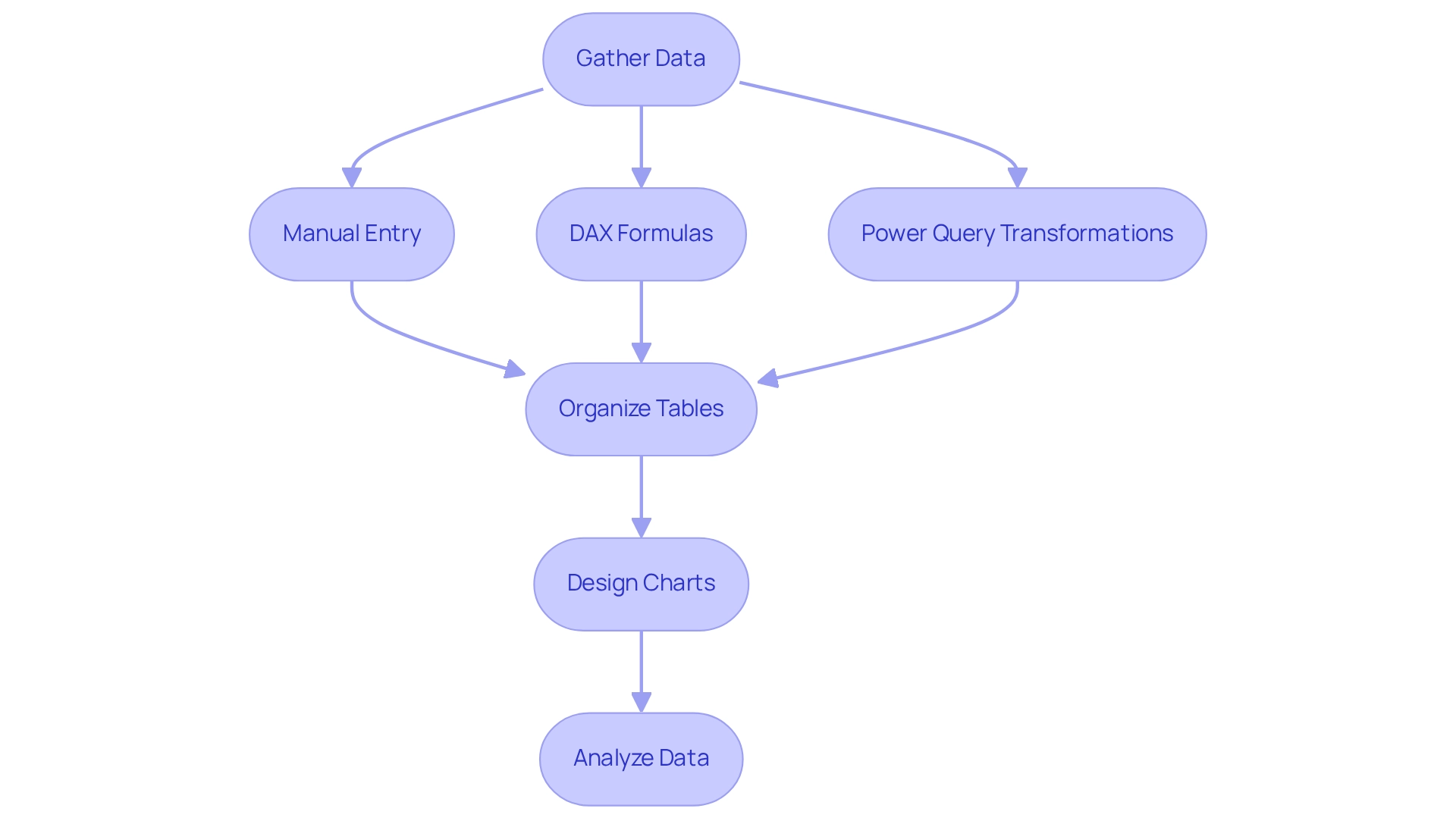
Methods for Creating New Tables in Power BI
Power BI provides a diverse array of methods for creating new tables, each tailored to specific use cases and user needs, significantly enhancing operational efficiency and supporting data-driven decision-making:
-
Enter Information: This straightforward method empowers users to manually input information directly into Power BI by selecting ‘Enter Information’ from the Home tab. It is particularly efficient for small collections or quick entries, enabling rapid information input without reliance on external sources. This minimizes the time spent on repetitive tasks.
-
DAX Table Constructor: Utilizing DAX (Data Analysis Expressions), individuals can create tables through formulas, which is especially advantageous for producing dynamic tables that adjust according to current information. This method enhances flexibility and allows for complex calculations and aggregations, making it a preferred choice among industry leaders. As organizations strive for growth and innovation, leveraging DAX can significantly boost operational efficiency and help overcome challenges in report creation and inconsistencies.
-
Query: This technique focuses on converting and loading information from various sources. Users can create new tables in Power BI from existing tables by merging or appending datasets, ideal for managing larger collections of data. The robust capabilities of Power Query streamline the preparation process, ensuring users can efficiently manage and manipulate their information, ultimately leading to better insights and informed decision-making.
-
Calculated Tables: Created using DAX expressions that reference other tables, calculated tables are instrumental in summarizing information or aggregating details. They provide a powerful means to derive insights from existing datasets, enhancing the analytical capabilities of Power BI and supporting the drive for data-driven insights.
Integrating Robotic Process Automation (RPA) can further optimize these processes, alleviating the burden of manual information handling and improving overall efficiency. A practical suggestion from industry expert Liang recommends, “Try to Unpivot the chart in query editor,” which can assist users in enhancing their information structure for improved analysis and operational efficiency.
By understanding and leveraging these methods, users can effectively create new tables in Power BI from existing data, driving operational efficiency and informed decision-making. Recent statistics indicate that the adoption of DAX for table creation is on the rise, reflecting its benefits in constructing intricate models and enhancing user experience. Organizations that effectively manage their information have reported median revenues of 71,000 units in 2023, underscoring the importance of these methods in fostering growth and innovation.
Furthermore, case studies illustrate how organizations have successfully utilized these methods to transform raw data into actionable insights, ultimately promoting growth and innovation in their operations. The recent DataViz World Championships for BI, held from February 14 to March 31, further emphasize the relevance and timeliness of BI in the current landscape, providing opportunities for users to showcase their skills and engage with the community. Creatum GmbH is dedicated to assisting companies in overcoming these challenges and harnessing the full potential of BI.
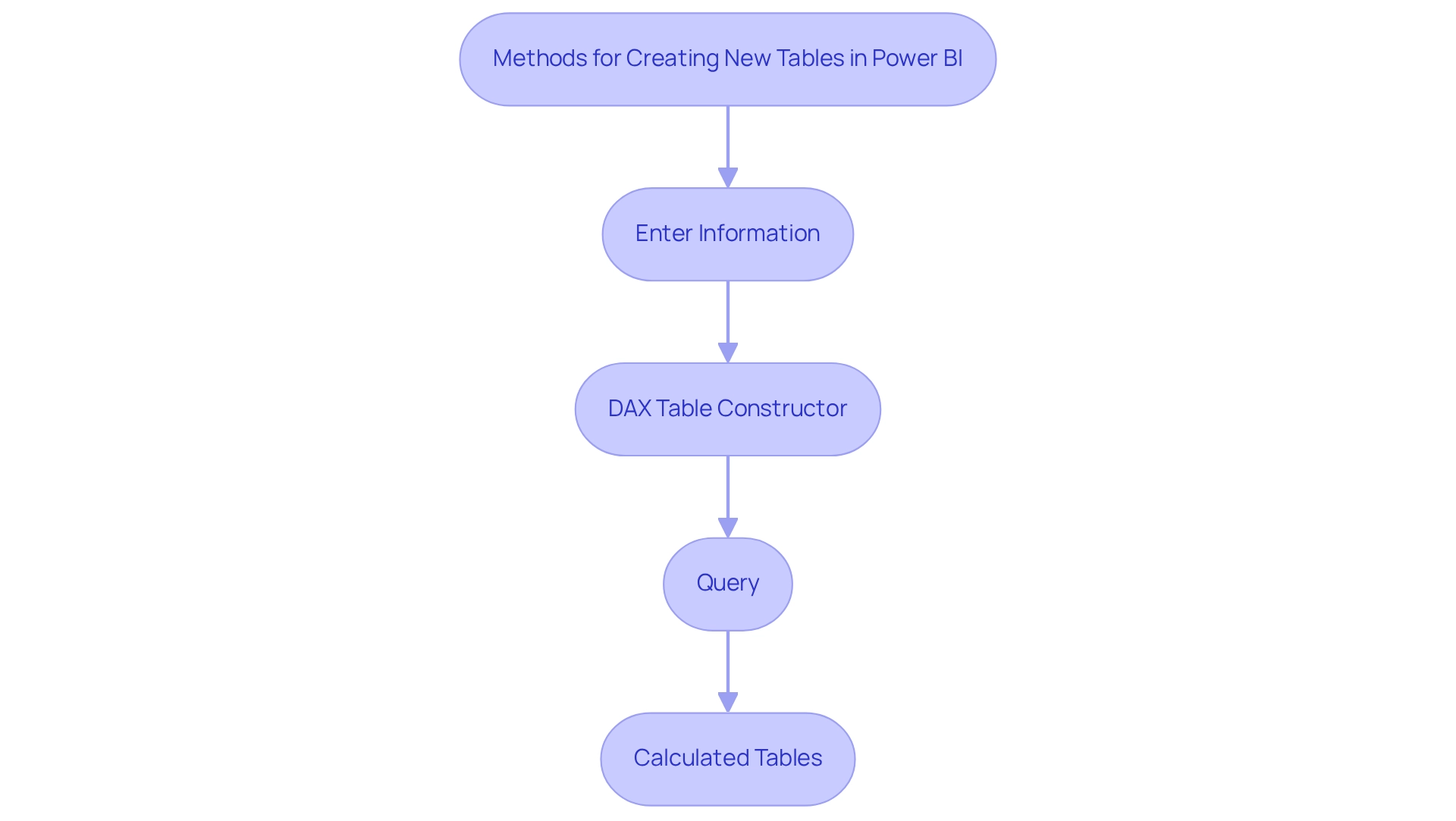
Step-by-Step Guide to Creating a Table Using DAX
Establishing a new chart in BI using DAX is a straightforward procedure that can significantly enhance your data analysis capabilities and address common organizational challenges. Follow these steps to efficiently create a new table:
-
Open Power BI Desktop: Begin by launching the application and opening your existing report.
-
Navigate to the Modeling Tab: Click on the ‘Modeling’ tab located in the ribbon at the top of the interface.
-
Select New Table: Choose ‘New Table’ to activate the formula bar where you will input your DAX expression.
-
Enter DAX Formula: In the formula bar, type your DAX expression. For instance:
new table = SUMMARIZE(existing table, existing table[existing table], existing table[Column2]) -
Press Enter: After entering your formula, press Enter to generate the new dataset.
-
View the New Structure: The recently established structure will now appear in the Fields pane, ready for incorporation into your reports.
Example DAX Expression: This example illustrates how to summarize data from an existing table based on specified columns, facilitating more focused analysis and helping to mitigate issues related to data inconsistencies.
Best Practices for DAX Table Creation:
- Optimize for Performance: When dealing with large datasets, be mindful of the maximum limit of 99,999 rows returned per query to ensure efficient processing. This limitation is crucial for maintaining performance when executing DAX queries in Power BI, particularly given the challenges of time-consuming report creation.
- Avoid Excessive Charts: As highlighted in community discussions, creating an abundance of charts can complicate your model, especially with large datasets. A community member noted, “I have a significantly large DataSet I am working on, so I am aiming to reach the end result with DAX language instead of additional datasets.” Instead, focus on utilizing DAX expressions that effectively summarize and filter information without the need for additional tables.
Importance of Actionable Guidance: To truly leverage insights from your Power BI dashboards, it is essential to ensure that your reports provide clear, actionable guidance. This assists stakeholders in understanding the subsequent actions based on the information provided, addressing the common issue of reports filled with figures but lacking direction.
Role of Business Intelligence and RPA: Integrating Business Intelligence and Robotic Process Automation (RPA) can significantly enhance operational efficiency and data-driven insights. By automating repetitive tasks and streamlining information processes, organizations can concentrate on analysis rather than report creation, ultimately driving growth and innovation.
Success Rates and Effectiveness: Users have reported high success rates when utilizing DAX for table creation, particularly when adhering to best practices. Recent statistics indicate that efficient DAX expressions can greatly improve information summarization, facilitating the extraction of actionable insights from complex datasets. Furthermore, a case study examined the challenges of organizing information in DAX, where a community member proposed establishing a grouping structure to filter the fact set by cancellation columns.
This underscores the importance of managing large datasets efficiently without generating unnecessary records. By mastering these techniques, you can streamline your reporting processes and enhance operational efficiency, ultimately harnessing the full potential of Business Intelligence and RPA for your organization.
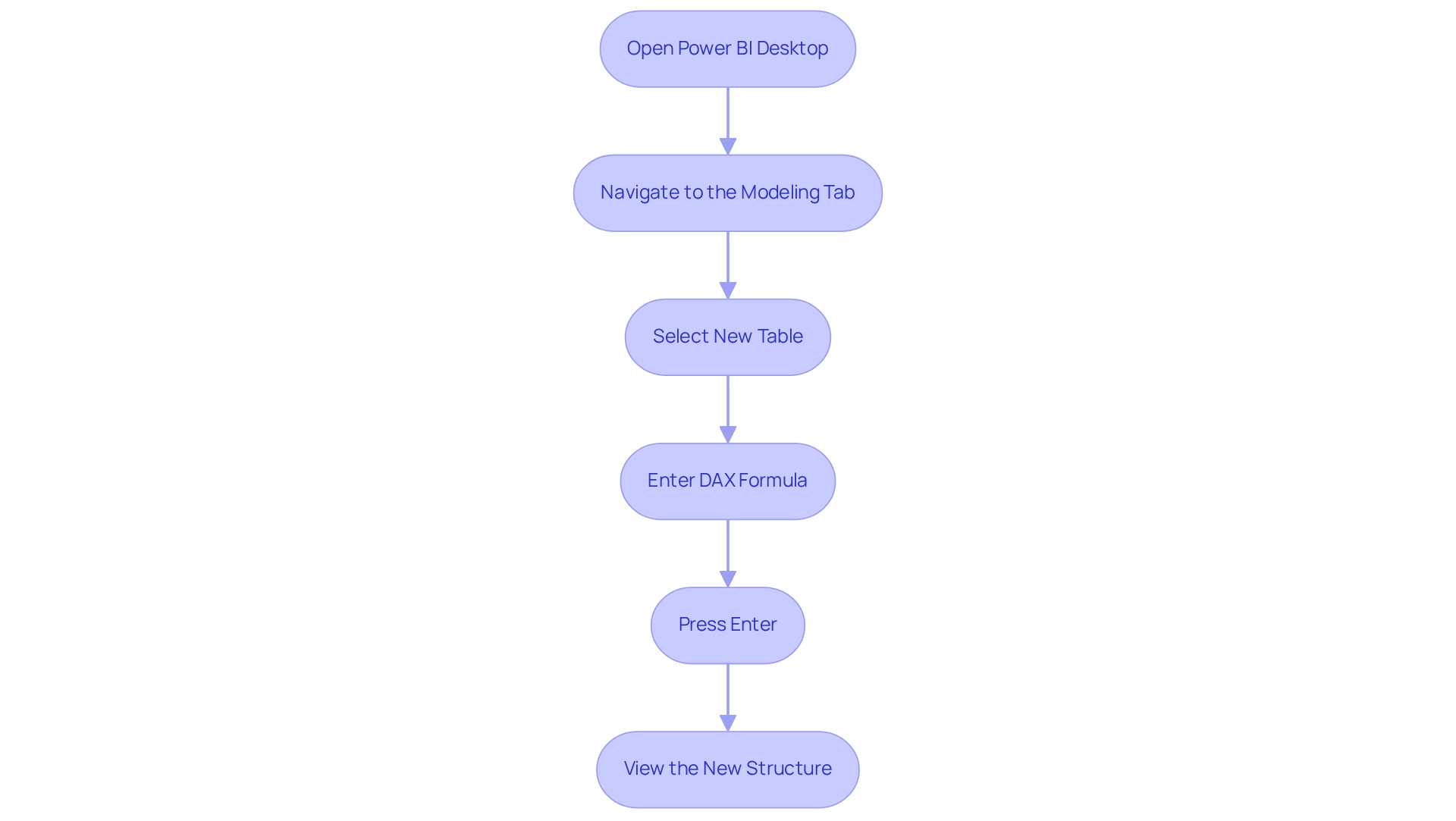
Creating Tables with Power Query: A Comprehensive Approach
Establishing a new structure in BI through Query empowers you to create new tables in Power BI from existing tables. This straightforward procedure can significantly enhance your data management capabilities and boost operational efficiency. Follow these steps to efficiently create and manage your tables:
- Open Power Query Editor: Launch Power BI Desktop and click on ‘Transform Data’ to access the Power Query Editor.
- Select a Source Dataset: Identify the dataset you wish to use as the foundation for your new dataset.
- Duplicate or Reference the Chart: Right-click on the selected chart and choose either ‘Duplicate’ to create an exact copy or ‘Reference’ to create a new query that links back to the original chart.
- Transform the Data: Implement necessary transformations, such as filtering rows, changing data types, or applying calculations to tailor the data to your needs. For instance, if you’re creating a summary chart, you might filter the original dataset to include only specific columns or rows based on defined criteria.
- Load the New Table: After completing your transformations, click ‘Close & Apply’ to import the new table into BI.
Best Practices for Power Query Table Creation
- Utilize Dictionary Encoding: Enabling dictionary encoding for repetitive text data can save space and enhance processing speed, making your data model more efficient.
- Leverage the ADD COLUMN / STATISTICS Feature: This feature allows for statistical aggregation across multiple columns, enabling you to calculate sums, averages, and other statistics seamlessly. As noted by dieter92, “The ADD COLUMN / STATISTICS idea of this is to do some statistics on several columns aggregation (not just two): sum of all columns, average of all, etc…”
Real-World Example
A notable case study involves MavenTech, which harnessed CRM data for insightful sales reporting. By utilizing Query, they automated the cleaning and transformation of raw information into a refined dataset. This automation significantly improved their ability to generate accurate, analysis-ready reports, laying a strong foundation for effective business intelligence reporting.
The implementation resulted in a 30% decrease in report generation time and enhanced information accuracy by 25%.
Time Efficiency
Research indicates that creating tables using Power Query can be completed in approximately 16 minutes, compared to the time-consuming manual entry process. This efficiency highlights the importance of utilizing Query to create new tables in Power BI from existing tables for transformation tasks in BI, especially in an information-rich setting where deriving significant insights is vital for sustaining a competitive advantage.
By adhering to these steps and best practices, you can simplify your information management processes in BI, ensuring that your records are not only precise but also enhanced for analysis, ultimately fostering growth and innovation. Moreover, incorporating RPA solutions from Creatum GmbH can further improve operational efficiency by automating repetitive tasks related to information management.
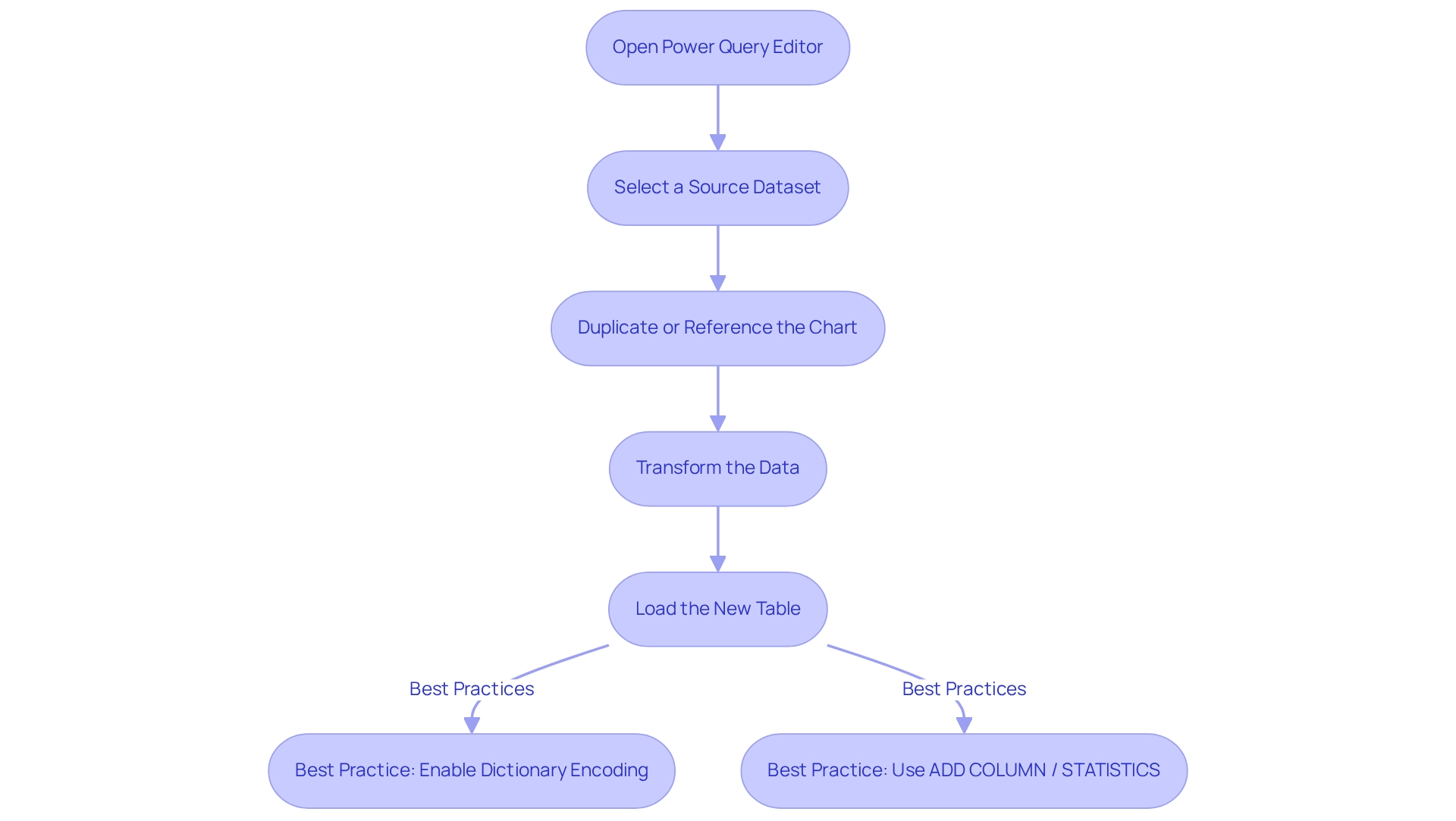
Utilizing Existing Tables to Create New Tables
Creating new tables from existing ones in Power BI can be accomplished through several effective methods, each tailored to enhance data management and analysis, ultimately driving operational efficiency and informed decision-making.
- Using DAX: The Data Analysis Expressions (DAX) language enables you to form new structures by aggregating or filtering information from current datasets. For instance, you can generate a new table that includes only those records where a specific column exceeds a certain value:
NewTable = FILTER(ExistingTable, ExistingTable[Column] > 100)
This method is particularly useful for creating targeted datasets that focus on specific criteria, addressing the challenge of time-consuming report creation in Power BI dashboards.
-
Power Query Merging: In Power Query, combining datasets is a straightforward process. By choosing ‘Merge Queries’, you can unite two or more datasets based on common columns. This method is advantageous for combining related datasets, providing a comprehensive perspective of your information and improving quality.
-
Appending Queries: When working with similar datasets, combining them can produce a new unified structure. This method is ideal for merging information from various sources, such as multiple sales regions or departments, into a single dataset for easier analysis, thus streamlining manual workflows.
-
Example of Merging Tables: Consider a scenario where you have a sales table and a customer table. By combining these two lists, you can generate a new record that features customer information alongside sales figures, offering a more comprehensive context for analysis. This integration not only improves information quality but also streamlines reporting processes, addressing the absence of actionable guidance frequently encountered in BI.
-
Best Practices and Insights: Industry leaders emphasize the importance of optimizing your data retrieval methods when merging tables. For example, utilizing
Table.Buffercan significantly improve performance, especially when working with large datasets. A case study highlighted a user who faced slow load times while appending data from 57 SharePoint sites, each containing multiple lists. By examining their strategy and applying best practices, they succeeded in improving efficiency, demonstrating how RPA, including solutions like EMMA RPA and Automate from Creatum GmbH, can support BI initiatives.
Statistics indicate that a significant percentage of users utilize existing tables to create new tables in Power BI from existing tables, underscoring the effectiveness of these methods in Business Intelligence. In fact, a message seeking solutions to similar problems garnered 13,076 views, reflecting the high demand for effective information management techniques. As organizations increasingly rely on data-driven decision-making, mastering these techniques is essential for operational efficiency and strategic growth.
Mitchell Pearson, a Platform Consultant and Training Manager, remarks, “This summary encapsulates the core lessons from the tutorial, aimed at professionals seeking to enhance their management capabilities in Power BI.” This strengthens the tutorial’s importance for those aiming to improve their abilities in information management. By focusing on enhancing data quality and simplifying AI implementation, organizations can drive growth and innovation in their data practices.
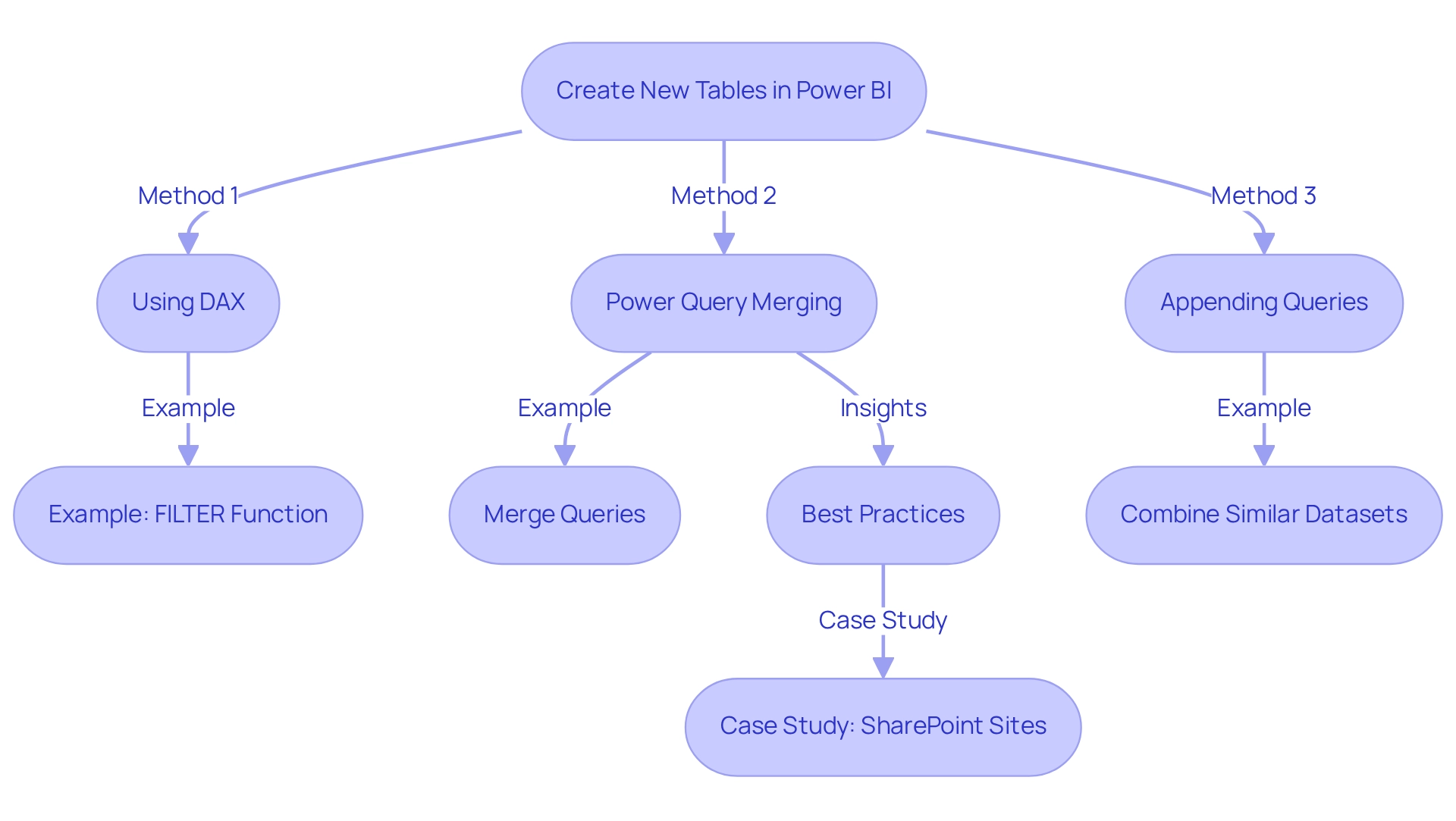
Best Practices for Creating and Managing Tables in Power BI
To optimize your table creation and management in Power BI, adhere to the following best practices:
-
Use Descriptive Names: Clearly name your structures and columns to accurately reflect their content. This practice not only aids comprehension but also enhances the overall clarity of your information model.
-
Limit Columns: Include only the necessary columns in your lists. This method reduces complexity, boosts performance, and ensures that users can navigate the information effortlessly.
-
Establish Relationships: Properly define relationships between tables. This is essential for facilitating efficient information analysis and reporting, enabling users to extract valuable insights from related datasets.
-
Regularly Review Information Models: Periodically evaluate your information models for efficiency and relevance. Eliminating outdated or unnecessary structures helps maintain a streamlined environment that promotes optimal performance.
-
Document Changes: Maintain a thorough log of modifications made to your tables and information models. This documentation fosters clarity and encourages collaboration among team members, ensuring everyone is aligned on the current framework and purpose of the information.
-
Establish a Clear Role Hierarchy: Implementing a clear role hierarchy simplifies permissions management in Power BI, ensuring that users have appropriate access to the data they need.
-
Encourage Collaboration: Foster an environment where team members can comment and annotate within reports. Establishing specialized collaborative environments enhances teamwork and facilitates more efficient resource management.
Example of Naming Conventions:
- Instead of using generic names like ‘Table1’, opt for specific names such as ‘SalesData_2025’. This not only enhances clarity but also aids in quickly identifying the purpose of each table.
As mentioned by Sascha Rudloff, Teamleader of IT- and Processmanagement at PALFINGER Tail Lifts GMBH, “With the BI Sprint from CREATUM, we not only received a readily usable BI report and a gateway setup but also experienced a significant acceleration in our own BI development.” The outcomes of the sprint surpassed our anticipations and served as a vital catalyst for our analysis strategy. This emphasizes the transformative effect of Creatum’s Business Intelligence Sprint on analytics development.
By applying these best practices, organizations can create new tables in Power BI from existing tables, significantly enhancing their BI table management and leading to improved information quality and more effective decision-making processes. Moreover, incorporating Robotic Process Automation (RPA) can simplify repetitive tasks related to information management, boosting operational efficiency. Customized AI solutions can also assist in tackling challenges associated with data analysis and reporting, ensuring that businesses derive meaningful insights from their BI dashboards.
Ultimately, these strategies drive growth and innovation for businesses.
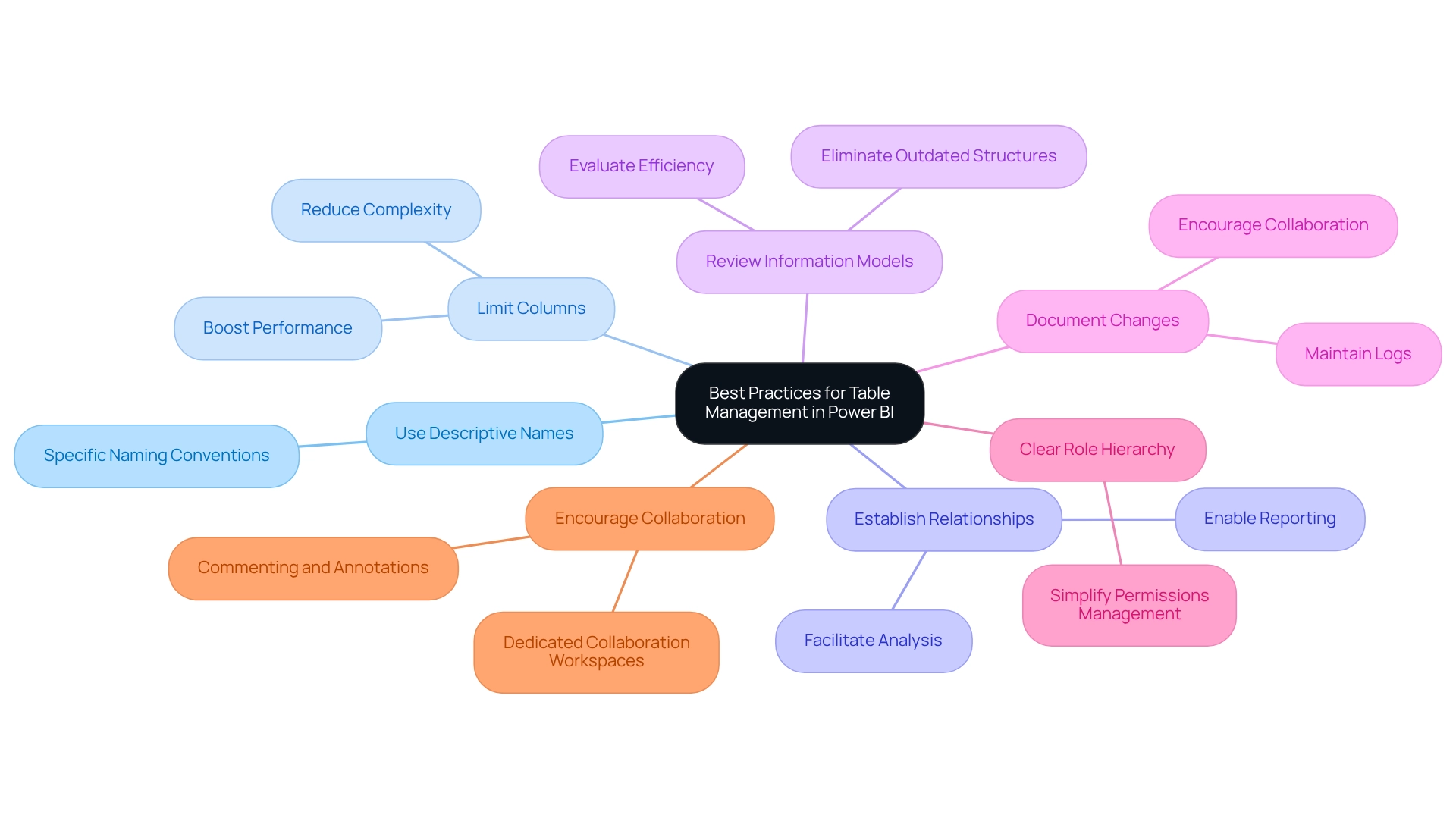
Troubleshooting Common Issues in Table Creation
Building charts in Power BI presents various challenges that can hinder your workflow. Here are some common issues along with expert solutions to help you navigate these obstacles effectively:
-
Error Messages: When you encounter error messages during table creation, it is essential to scrutinize your DAX syntax. Look for mistakes or missing elements that could be causing the issue. Tools like the Tabular Editor Best Practice Analyzer can help identify unnecessary columns that may complicate your model. Statistics indicate that utilizing this tool can significantly reduce mistakes in your information model, ultimately enhancing your Business Intelligence initiatives.
-
Data Type Mismatches: Data type mismatches frequently lead to errors when merging or appending columns. Ensure that the types of the columns involved are compatible. A substantial percentage of errors in Power BI stem from these mismatches, so verifying types can save time and frustration, enabling smoother insights based on information.
-
Performance Issues: If your reports are running slowly, consider optimizing your DAX calculations and reducing the number of columns in your tables. Enhancing your information model not only boosts performance but also improves the overall user experience. Additionally, updating the model, verifying sources for structural changes, and clearing the Power BI cache are crucial steps for resolving model issues—though time-consuming, they are vital for operational efficiency.
-
Relationship Conflicts: Challenges in establishing connections between entities often arise from incompatible categories or values in the columns used for relationships. Confirm that these columns align in both type and content to establish successful relationships, which is critical for accurate reporting and analysis.
Example of Resolving Errors: For instance, if you encounter a ‘maximum size exceeded’ error, simplifying your data model by removing unnecessary tables or columns can be beneficial. This method not only rectifies the error but also enhances the efficiency of your BI reports. Remember, using the DIVIDE function in DAX instead of ‘/’ can help avoid errors when the denominator is 0.
By addressing these common problems with targeted solutions, you can significantly improve your experience in creating new tables in Power BI from existing ones, ultimately leading to more effective data analysis and decision-making. As Gusdate2, a helper, noted, “I didn’t think to unpivot,” highlighting a frequent oversight that can complicate the creation of the structure. Furthermore, the case study titled “Business Intelligence for Informed Decision-Making” illustrates how organizations empower businesses to derive meaningful insights, underscoring the importance of efficient management in fostering growth and innovation.
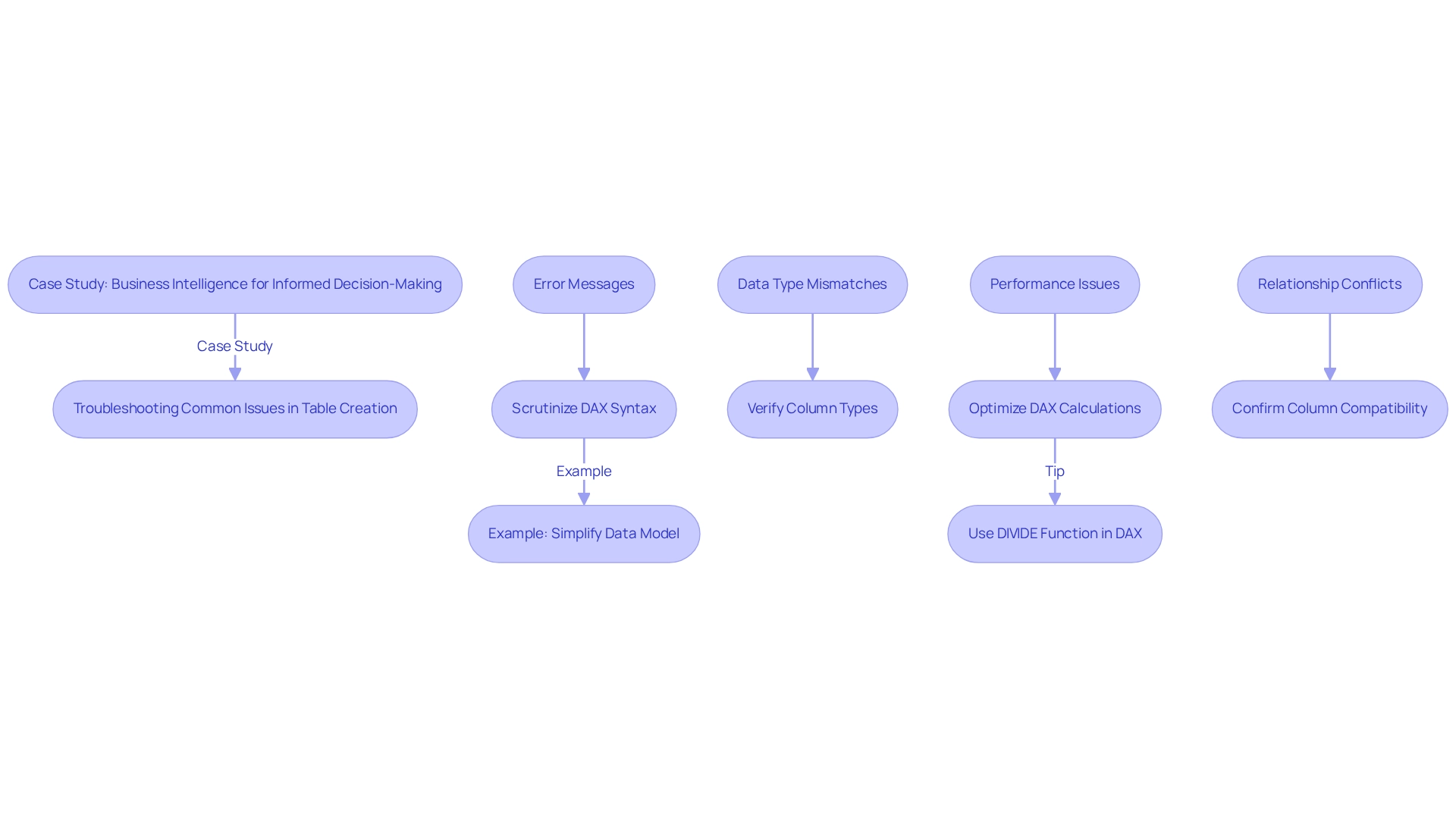
Key Takeaways and Next Steps in Power BI Table Creation
Creating a new table in Power BI from existing tables can be accomplished through various methods, including manual entry, DAX, and Query. Mastering these techniques is essential for effective data modeling and leveraging Business Intelligence to drive informed decision-making. To enhance your Power BI skills and operational efficiency, consider the following next steps:
- Practice Creating Structures: Engage in hands-on experimentation with various techniques to produce layouts tailored to your datasets. This practical experience will deepen your understanding and enhance your skills, ultimately improving your ability to derive actionable insights from your data.
- Explore Advanced DAX Functions: Delve deeper into DAX to uncover advanced techniques for table creation. Approximately 30% of users are already utilizing advanced DAX functions, significantly enhancing their data manipulation capabilities and addressing common challenges such as data inconsistencies.
- Utilize RPA for Efficiency: Consider how Robotic Process Automation (RPA) can streamline your workflow alongside BI. By automating repetitive tasks, RPA solutions like EMMA RPA can alleviate task repetition fatigue, allowing your team to focus on more strategic, value-adding work.
- Join BI Communities: Actively participate in BI communities to share insights and learn from others’ experiences. As Henry from Community Support noted, “Here is a solution on how to connect Twitter, Facebook, and YouTube using BI, hope to assist you.” Engaging with peers can provide valuable perspectives on overcoming challenges and implementing effective solutions, particularly in the context of time-consuming report creation.
- Stay Informed: Regularly check for new features and updates in BI. Continuous learning is crucial in this rapidly evolving field, and staying informed about the latest enhancements will enable you to leverage the full potential of the tool, ensuring effective use of BI for strategic decision-making.
Additionally, consider the case study titled “Business Intelligence for Insights,” which underscores the importance of extracting valuable insights from unprocessed information for informed decision-making. Understanding how to handle information efficiently in BI can transform your analytical methods and operational effectiveness.
By following these steps, you can effectively create new tables in Power BI from existing tables, enabling you to convert raw information into actionable insights that drive informed decision-making. Remember, the journey of mastering Power BI is ongoing, and each step you take contributes to your growth in this data-rich environment. Also, be aware that usage metrics reports are not supported for My Workspace and do not capture usage for embedded dashboards, which is vital for understanding data access and management.
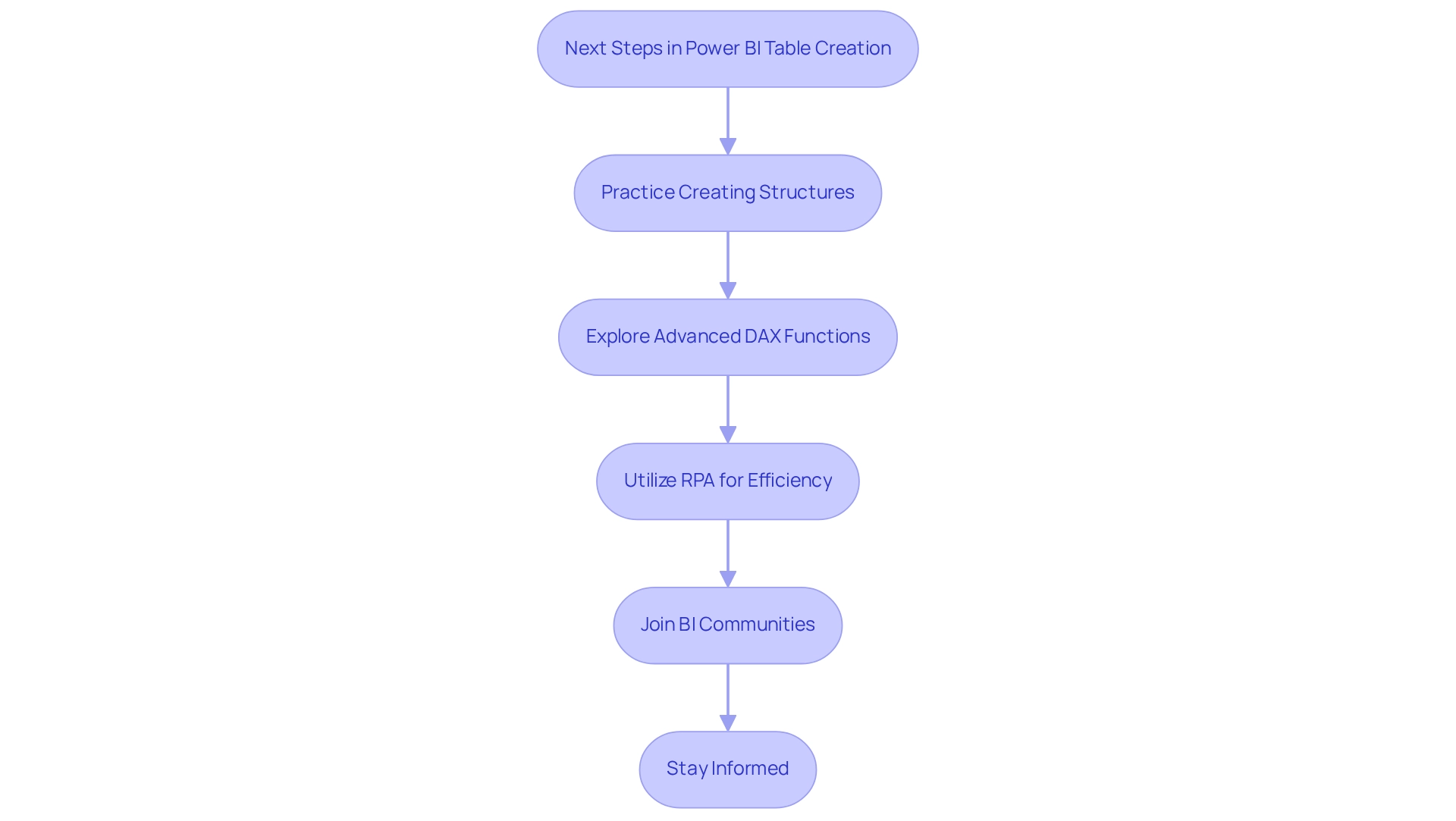
Conclusion
Mastering table creation and management in Power BI is essential for organizations aiming to harness their data’s power. This article has explored various methods for creating tables, including manual entry, DAX formulas, and Power Query transformations. Each method presents unique advantages, catering to different use cases and enhancing operational efficiency.
The significance of well-structured tables cannot be overstated. By employing best practices—such as using descriptive names, limiting unnecessary columns, and establishing clear relationships between tables—users can improve data quality and facilitate better decision-making. Additionally, addressing common challenges like error messages and data type mismatches ensures a smoother workflow and enhances overall performance.
Ultimately, effectively managing tables in Power BI transforms raw data into actionable insights, driving informed decision-making and operational efficiency. As organizations navigate the complexities of data analytics, implementing robust table structures and leveraging advanced techniques will be crucial for sustaining growth and innovation. Engaging in continuous learning and utilizing available resources, including community support and automation solutions, will empower users to unlock the full potential of Power BI and navigate the data-driven landscape with confidence.
Frequently Asked Questions
What role do grids play in Power BI?
Grids in Power BI are essential components for organizing information, presenting it in a structured format of rows and columns. They encapsulate distinct datasets, such as sales transactions or customer profiles, which are vital for effective analysis and visualization.
How significant are charts in Business Intelligence (BI)?
Charts are recognized as critical components in the analytical processes of approximately 80% of companies utilizing BI for data visualization, underscoring their importance in effective data analysis.
What methods does Power BI provide for creating new tables?
Power BI offers several methods for creating new tables, including: 1. Enter Information: Manual entry of data directly into Power BI. 2. DAX Table Constructor: Using DAX formulas to create dynamic tables. 3. Query: Converting and loading information from various sources, merging or appending datasets. 4. Calculated Tables: Using DAX expressions that reference other tables to summarize or aggregate information.
Why is it important to design tables that are understandable on their own?
Designing tables to be understandable without reference to text fosters clarity and facilitates better decision-making, as emphasized by David J. Slutsky, Assistant Professor at Harbor-UCLA Medical Center.
How can organizations improve information integrity and streamline reporting processes?
Organizations can improve information integrity and streamline reporting processes by implementing robust framework structures and utilizing tools like the General Management App provided by Creatum, which addresses consistency and governance challenges.
What benefits do organizations report from establishing strong frameworks in BI?
Organizations that establish strong frameworks report substantial improvements in information integrity and analytical efficiency, enabling them to create intricate models for thorough analysis and trend uncovering.
How do tools like heat maps enhance data visualization in Power BI?
Tools such as heat maps enhance the visualization of trends and associations, simplifying the interpretation of complex datasets and aiding in better data analysis.
What impact did the 3-Day Power BI Sprint from Creatum have on PALFINGER Tail Lifts GmbH?
The 3-Day Power BI Sprint provided by Creatum delivered an immediately usable Power BI report and significantly expedited their Power BI development, highlighting the efficiency of proper information management in BI.
What is the significance of employing DAX in Power BI?
DAX enhances flexibility and allows for complex calculations and aggregations, making it a preferred choice among industry leaders for creating dynamic tables and improving operational efficiency.
What recent statistics indicate about the adoption of DAX for table creation?
Recent statistics show an increase in the adoption of DAX for table creation, reflecting its benefits in constructing intricate models and enhancing user experience, contributing to organizational growth and innovation.

